Farmer Perceptions and Climate Change Adaptation in the West Africa Sudan Savannah: Reality Check in Dassari, Benin, and Dano, Burkina Faso
Abstract
:1. Introduction
1.1. Climate Change and Farmers’ Perceptions
1.2. Implementation of Adaptation Measures
2. Materials and Methods
2.1. Research Sites
2.2. Methodology
3. Results and Discussion
3.1. Farmer Perceptions
3.1.1. Group Interviews
3.1.2. Interviews with Elderly Farmers
“Everything has changed. The heat. There is a lot of heat. Before there was not much heat […], the wind, the wind is too much, too fast […] brings the illnesses, diseases. The rain also. Everything has changed!” “Nature had a calendar that was respected, now there is no longer such a calendar. It used to indicate when to start [agricultural activities], now it just happens like that…”(Mr. D. K., Dassari, 20 April 2013)
“Before, with my dad, a small portion [of land] used to gain a lot, now with a large portion one does not gain a lot. There is no fertility anymore, the rain, it is not as before, there is a change.”(Mr. P. D., Dano, 26 April 2013)
“It can be called: ‘la vie d’aujourd´hui’ (the life of today). This is the expression! The change we can see. […] Nowadays there are no trees. The rain is rare. Cannot say why it is like this nowadays. I do not know why. I have seen the changes but I do not know who is responsible”(Mr. D. K., Dassari, 20 April 2013)
“It is only God who knows who is responsible”(Mr. S. Y., Dano, 27 April 2013)
“Before, there were the totems which forbade us to do certain things. But meanwhile the [fellow] Africans have started to do what is forbidden […] and the change was sent. Voila!”(Mr. S. O., Dano, 25 April 2013)
“There is no responsibility, neither by the government nor by anybody else. It simply does not rain and the soils are poor”(Mr. J. L. D., Dano, 24 April 2013)
“The first issue is the man. That is it. When my grandpa was here there were lots of trees, big trees. He did not chop [cut] them. Now we have chopped all of them! It is the man! [Q: Maybe there are other causes?] No, no! It is the man. Is the man, the one that does it. It happened, in the time of my mom […] she watched the foreigners who came, who confirmed that the man was the problem, and now we gradually understand, and therefore have to change […]”(Mr. A. Q., Dano, 20 April 2013)
“In the past you could work the field [because the soil was fertile], now you are obliged to utilize chemicals! To use organic manure and ask for fertilizer from the government. So we use both! […] If we were not be able to use the fertilizer for farming we would have to leave to look for new lands. So the organic manure and the fertilizers from the government!”(Mr. D. K., Dano, 20 April 2013)
“A way to address the change is: In the past there were reunions and now one calls the people to come but they do not come. Then the solution is to attend the meeting and find the solution. So there is [will not be] no problem”(Mr. S. O., village chef, Dano, 25 April 2013)
“We have to ask for an excuse. We have to ask for pardon. To him who knows [the ‘Sage’: local wise man], who knows what comes, who knows what is the truth. He is who knows and watches the fetish to ask him to pray to bring the weather back from before”(Mr. D. K., Dassari, 20 April 2013)
3.1.3. Household Survey
3.2. Coping Measures and Adaptation Strategies
3.3. Views of Government Agencies and NGOs
4. Conclusions
Supplementary Materials
Acknowledgments
Conflicts of Interest
References
- Intergovernmental Panel on Climate Change. Contribution of Working Groups I, II and III to the Fifth Assessment Report of the Intergovernmental Panel on Climate Change; Climate Change 2014: Synthesis Report; Pachauri, R.K., Meyer, L.A., Eds.; Intergovernmental Panel on Climate Change: Geneva, Switzerland, 2014; 151p. [Google Scholar]
- Collins, J.M. Temperature variability over Africa. J. Clim. 2011, 24, 3649–3666. [Google Scholar] [CrossRef]
- Hulme, M.; Doherty, R.; Ngara, T.; New, M.; Lister, D. African Climate Change: 1900–2100. Clim. Res. 2001, 17, 145–168. [Google Scholar] [CrossRef]
- Nicholson, S.E. Climatic and Environmental Change in Africa during the Last Two Centuries. Clim. Res. 2001, 17, 123–144. [Google Scholar] [CrossRef]
- Sanchez, P. Soil fertility and hunger in Africa. Science 2002, 295, 2019–2020. [Google Scholar] [CrossRef] [PubMed]
- Challinor, A.; Wheeler, T.; Garforth, C.; Craufurd, P.; Kassam, A. Assessing the vulnerability of food crop systems in Africa to climate change. Clim. Chang. 2007, 83, 381–399. [Google Scholar] [CrossRef]
- Valbuena, D.; Erenstein, O.; Homann-KeeTui, S.; Abdoulaye, T.; Claessens, L.; Duncan, A.J.; Gérard, B.; Rufino, M.C.; Teufel, N.; van Rooyen, A.; et al. Conservation Agriculture in mixed crop–livestock systems: Scoping crop residue trade-offs in Sub-Saharan Africa and South Asia. Field Crop. Res. 2012, 132, 175–184. [Google Scholar] [CrossRef]
- Callo-Concha, D.; Gaiser, T.; Webber, H.; Tischbein, B.; Müller, M.; Ewert, F. Farming in the West African Sudan Savanna: Insights in the Context of Climate Change. Afr. J. Agric. Res. 2013, 8, 4693–4705. [Google Scholar] [CrossRef]
- Niang, I.; Ruppel, O.C.; Abdrabo, M.A.; Essel, A.; Lennard, C.; Padgham, J.; Urquhart, P. Africa. Part B: Regional Aspects. Contribution of Working Group II to the Fifth Assessment Report of the Intergovernmental Panel on Climate Change. In Climate Change 2014: Impacts, Adaptation, and Vulnerability; Barros, V.R., Field, C.B., Dokken, D.J., Mastrandrea, M.D., Mach, K.J., Bilir, T.E., Chatterjee, M., Ebi, K.L., Estrada, Y.O., Genova, R.C., et al., Eds.; Cambridge University Press: Cambridge, UK; New York, NY, USA, 2014; pp. 1199–1265. ISBN 9789291691418. [Google Scholar]
- Climate and Development Knowledge Network (CDKN). Available online: http://cdkn.org/resource/highlights-africa-ar5 (accessed on 14 April 2015).
- Roncoli, C. Ethnographic and participatory approaches to research on farmers´ responses to climate predictions. Clim. Res. 2006, 33, 81–99. [Google Scholar] [CrossRef]
- Nakashima, D.; Galloway McLean, K.; Thulstrup, H.; Ramos-Castillo, A.; Rubis, J. Weathering Uncertainty: Traditional Knowledge for Climate Change Assessment and Adaptation; UNESCO and United Nations University. Traditional Knowledge Initiative: Darwin, Australia, 2012; 120p, ISBN 9789230010683. [Google Scholar]
- Adger, W.N.; Pulhin, J.M.; Barnett, J.; Dabelko, G.D.; Hovelsrud, G.K.; Levy, M.; Oswald, Ú.; Vogel, C.H. Human security. Part A: Global and Sectoral Aspects. Contribution of Working Group II to the Fifth Assessment Report of the Intergovernmental Panel on Climate Change. In Climate Change 2014: Impacts, Adaptation, and Vulnerability; Field, C.B., Barros, V.R., Dokken, D.J., Mach, K.J., Mastrandrea, M.D., Bilir, T.E., Chatterjee, M., Ebi, K.L., Estrada, Y.O., Genova, R.C., et al., Eds.; Cambridge University Press: Cambridge, UK; New York, NY, USA, 2014; pp. 755–791. ISBN 9781107641655. [Google Scholar]
- Kettle, N.P.; Dow, K.; Tuler, S.; Webler, T.; Whitehead, J.; Miller, K.M. Integrating scientific and local knowledge to inform risk-based management approaches for climate adaptation. Clim. Risk Manag. 2014, 4–5, 17–31. [Google Scholar] [CrossRef]
- Ford, J.D.; Cameron, L.; Rubis, J.; Maillet, M.; Nakashima, D.; Willox, A.C.; Pearce, T. Including indigenous knowledge and experience in IPCC assessment reports. Nat. Clim. Chang. 2016, 6, 349–353. [Google Scholar] [CrossRef]
- Cannon, T.D.; Müller-Mahn, D. Vulnerability, resilience and development discourses in context of climate change. Nat. Hazards 2010, 55, 621–635. [Google Scholar] [CrossRef]
- Mertz, O.; Mbow, C.; Nielsen, J.Ø.; Maiga, A.; Diallo, D.; Reenberg, A.; Diouf, A.; Barbier, B.; Bouzou Moussa, I.; Zorom, M.; et al. Climate factors play a limited role for past adaptation strategies in West Africa. Ecol. Soc. 2010, 15, 25. [Google Scholar] [CrossRef]
- Eguavoen, I.; zur Heide, F. Klimawandel und Anpassungsforschung in Äthiopien. Zeitschrift für Ethnologie 2012, 137, 97–118. [Google Scholar]
- Saidou, A.; Kuyper, T.W.; Kossou, D.K.; Tossou, R.; Richards, R. Sustainable Soil Fertility Management in Benin: Learning from Farmers. NJAS-Wagening. J. Life Sci. 2004, 52, 349–369. [Google Scholar] [CrossRef]
- Bryan, E.; Deressa, T.T.; Gbetibouo, G.A.; Ringler, C. Adaptation to climate change in Ethiopia and South Africa: Options and constraints. Environ. Sci. Policy 2009, 12, 413–426. [Google Scholar] [CrossRef]
- Cuni Sanchez, A.; Fandohan, B.; Assogbadjo, A.E.; Sinsin, B. A countrywide multi-ethnic assessment of local communities´ perception of climate change in Benin (West Africa). Clim. Dev. 2012, 4, 114–128. [Google Scholar] [CrossRef]
- Yaro, J.A. The perception of and adaptation to climate variability/change in Ghana by small-scale and commercial farmers. Reg. Environ. Chang. 2013, 13, 1259–1272. [Google Scholar] [CrossRef]
- Hillel, D.; Rosenzweig, C. Climate Change and Agroecosystems: Main Findings and Future Research Directions. In Handbook of Climate Change and Agroecosystems: Impacts, Adaptation and Mitigation; Hillel, D., Rosenzweig, C., Eds.; Imperial College Press: London, UK, 2011; pp. 429–435. ISBN 978-1-84816-655-4. [Google Scholar]
- Bationo, A.; Vlek, P. The role of nitrogen fertilizers applied to food crops in the Sudano Sahelian zone of West Africa. In Soil Fertility Management in West African Land Use Systems; Renard, G., Neef, A., Becker, K., Oppen, M., Eds.; Margaf Verlag: Weikersheim, Germany, 1998; pp. 41–51. [Google Scholar]
- Schlesinger, W.H. Carbon sequestration in soils. Science 1999, 284, 2095. [Google Scholar] [CrossRef]
- Food and Agriculture Organization of the United Nations (FAO). Investing in Sustainable Agricultural Intensification. The Role of Conservation Agriculture—A Framework for Action; Food and Agriculture Organization of the United Nations: Rome, Italy, 2008; 24p. [Google Scholar]
- Naab, J.; Bationo, A.; Wafula, B.M.; Traore, P.S.; Zougmore, R.; Ouattara, M.; Tabo, R.; Vlek, P.L.G. African Perspectives on Climate Change and Agriculture: Impacts, Adaptation, and Mitigation Potential. In Handbook of Climate Change and Agroecosystems Global and Regional Aspects and Implications; ICP Series on Climate Change Impacts, Adaptation, and Mitigation; Hillel, D., Rosenzweig, C., Eds.; Imperial College Press: London, UK, 2012; Volume 2, pp. 85–106. ISBN 978-1-84816-983-8. [Google Scholar]
- Steenhuis, T.S.; Masiyandima, M.C.; van de Giesen, N.; Diatta, S.; Windmeijer, P.N. The hydrology of inland valleys in the sub-humid zone of West Africa: Rainfall-runoff processes in the M’bé experimental watershed. Hydrol. Process. 2003, 17, 1213–1225. [Google Scholar] [CrossRef]
- Sandwidi, J.P. Groundwater Potential to Supply Population Demand within the Kompienga Dam Basin in Burkina Faso. Ph.D. Thesis, Center for Development Research, University of Bonn, Bonn, Germany, 2007. [Google Scholar]
- Mdemu, M.; Laube, W.; Barry, B. Temporal water productivity of tomato irrigated from a small reservoir and hand-dug wells in dry season cropping in the Upper East Region, Ghana. J. Appl. Irrig. Sci. 2010, 45, 75–93. [Google Scholar]
- Crane, T.A.; Roncoli, C.; Hoogenboom, G. Adaptation to Climate Change and Climate Variability: The Importance of Understanding Agriculture as Performance. NJAS-Wagening. J. Life Sci. 2011, 57, 179–185. [Google Scholar] [CrossRef]
- Maddison, D. The Perception of and Adaptation to Climate Change in Africa. Available online: http://elibrary.worldbank.org/doi/pdf/10.1596/1813-9450-4308 (accessed on 3 June 2016).
- Deressa, T.T.; Hassan, R.M.; Ringler, C.; Alemu, T. Yesuf, M. Determinants of farmers’ choice of adaptation methods to climate change in the Nile Basin of Ethiopia. Glob. Environ. Chang. 2009, 19, 248–255. [Google Scholar] [CrossRef]
- Ringler, C. Climate Change and Hunger: Africa’s Smallholder Farmers Struggle to Adapt. EuroChoices 2010, 9, 16–21. [Google Scholar] [CrossRef]
- Fosu-Mensah, B.Y.; Vlek, P.L.G.; MacCarthy, D.S. Farmers’ perception and adaptation to climate change: A case study of Sekyedumase district in Ghana. Environ. Dev. Sustain. 2012, 14, 495–505. [Google Scholar] [CrossRef]
- Nhemachena, C.; Hassan, R. Micro-Level Analysis of Farmers’ Adaptation to Climate Change in Southern Africa; IFPRI Discussion Paper 00714; International Food Policy Research Institute: Washington, DC, USA, 2007. [Google Scholar]
- Mertz, O.; Mbow, C.; Reenberg, A.; Diouf, A. Farmers’ Perceptions of Climate Change and Agricultural Adaptation Strategies in Rural Sahel. Environ. Manag. 2009, 43, 804–816. [Google Scholar] [CrossRef] [PubMed]
- Stoorvogel, J.; Smaling, E.M.A. Assessment of Soil Nutrient Depletion in Sub-Sahara 1983–2000; Winand Staring Centre: Wageningen, The Netherlands, 1990; 47p. [Google Scholar]
- Giller, K.E.; Witter, E.; Corbeels, M.; Tittonell, P. Conservation agriculture and smallholder farming in Africa: The heretics’ view. Field Crop. Res. 2009, 114, 23–34. [Google Scholar] [CrossRef]
- Rusinamhodzi, L.; Corbeels, M.; van Wijk, M.T.; Rufino, M.; Nyamangara, J.; Giller, K.E. A meta-analysis of long-term effects of conservation agriculture on maize grain yield under rain-fed conditions. Agron. Sustain. Dev. 2011, 31, 657–673. [Google Scholar] [CrossRef] [Green Version]
- Leakey, R. Living with the Trees of Life: Towards the Transformation of Tropical Agriculture; CABI: Wallingford, UK, 2012; 224p, ISBN 978-1780640983. [Google Scholar]
- Ifejika, S.C. Resilient Adaptation to Climate Change in African Agriculture; Deutsches Institut für Entwicklungspolitik: Bonn, Germany, 2010; ISBN 978-3-88985-489-6. [Google Scholar]
- Callo-Concha, D.; Ewert, F. Using the Concepts of Resilience, Vulnerability and Adaptability for the Assessment and Analysis of Agricultural Systems. Chang. Adapt. Soc.-Ecol. Syst. 2014, 1. [Google Scholar] [CrossRef]
- Pretty, J.; Toulmin, C.; Williams, S. Sustainable intensification in African agriculture. Int. J. Agric. Sustain. 2011, 9, 5–24. [Google Scholar] [CrossRef]
- Wheeler, T.; von Braun, J. Climate Change Impacts on Global Food Security. Science 2013, 341, 508–513. [Google Scholar] [CrossRef] [PubMed]
- Paavola, J. Livelihoods, vulnerability and adaptation to climate change in Morogoro, Tanzania. Environ. Sci. Policy 2008, 11, 642–654. [Google Scholar] [CrossRef]
- Barbier, B.; Yacouba, H.; Karambiri, H.; Zoromé, M.; Somé, B. Human Vulnerability to Climate Variability in the Sahel: Farmers’ Adaptation Strategies in Northern Burkina Faso. Environ. Manag. 2009, 43, 790–803. [Google Scholar] [CrossRef] [PubMed]
- Diallo, I.; Sylla, M.B.; Giorgi, F.; Gaye, A.T.; Camara, M. Multimodel GCM-RCM Ensemble-Based Projections of Temperature and Precipitation over West Africa for the Early 21st Century. Int. J. Geophys. 2012, 972896. [Google Scholar] [CrossRef]
- Ouédraogo, E. Soil Quality Improvement for Crop Production in Semi-Arid West Africa. Ph.D. Thesis, Wageningen University, Wageningen, The Netherlands, 2004. [Google Scholar]
- Laube, W. Changing Natural Resource Regimes in Northern Ghana. Actors, Structure and Institutions; ZEF Development Studies; Lit Verlag Dr. W. Hopf. Münster: Münster, Germany, 2007; 392p, ISBN 978-3-8258-0641-5. [Google Scholar]
- Windmeijer, P.; Andriesse, W. Inland Valleys in West Africa: An Agro-Ecological Characterization of Rice Growing Environments; International Institute for Land Reclamation and Improvement: Wageningen, The Netherlands, 1993; 160p, ISBN 9070754320. [Google Scholar]
- Barbier, E.B. The economic linkages between rural poverty and land degradation: Some evidence from Africa. Agric. Ecosyst. Environ. 2000, 82, 355–370. [Google Scholar] [CrossRef]
- Igue, A.M.; Floquet, A.; Stahr, K. Land use and farming systems in Benin. In Adapted Farming in West Africa: Issues, Potentials and Perspectives; Graef, F., Lawrence, P., von Oppen, M., Eds.; Verlag Ulrich E. Grauer: Stuttgart, Germany, 2000; pp. 227–238. ISBN 3-86186-315-4. [Google Scholar]
- Institute National de la Statistique et de l´Analyse Economique (INSAE). Population Beninoise en Age de Voter en 2006. Available online: http://web.stanford.edu/group/solarbenin/data/BeninDemographics/Census%20population%20summary.pdf (accessed on 1 June 2017).
- Stechert, C. Einsatz von Insektiziden im Baumwollanbau in Benin und deren Auswirkung auf Nicht-Zielorganismen. Ph.D. Thesis, Braunschweig University, Braunschweig, Germany, 2011. [Google Scholar]
- World Bank. Climate Change Knowledge Portal. Available online: http://sdwebx.worldbank.org/climateportal/ (accessed on 8 June 2016).
- Republique du Benin, Departement de l’Atacora. Plan de Development Economique et Social de Matéri. Available online: http://www.ancb-benin.org/pdc-sdaconographies/PDC/Atacora/PDC%20Mat%C3%A9ri.pdf (accessed on 8 June 2006).
- Institute National de la Statistique et Démographie. Resultats Preliminaires du Recensement General de la Population et de l’habitation de 2006. p. 49. Available online: http://www.insd.bf/documents/publications/insd/publications/resultats_enquetes/autres%20enq/Rapport_preliminaire_RGPH06.pdf (accessed on 1 June 2017).
- Gleisberg-Gerber, K. Livelihoods and Land Management in the Ioba Province in South Western Burkina Faso; ZEF Working Paper 91; Center for Development Research: Bonn, Germany, 2012. [Google Scholar]
- Schmengler, A.C. Modeling Soil Erosion and Reservoir Sedimentation at Hillslope and Catchment Scale in Semi-Arid Burkina Faso; Center for Development Research, Ecology and Development Series No. 80; Center for Development Research: Bonn, Germany, 2011; 236p, ISBN 9783940124319. [Google Scholar]
- Climatic Research Unit of University of East Anglia. Available online: https://crudata.uea.ac.uk/cru/data/temperature/ (accessed on 1 June 2017).
- Eguavoen, I.; Wahren, J. Climate Change Adaptation in Burkina Faso: Aid Dependency and Obstacles to Political Participation; ZEF Working Paper 140; Center for Development Research: Bonn, Germany, 2015. [Google Scholar]
- Eguavoen, I.; Schulz, K.; De Wit, S.; Weisser, F.; Müller-Mahn, D. Political dimensions of climate change adaptation. Conceptual reflections and African examples. In Handbook of Climate Change Adaptation, 2, Policy and Climate Change; Leal Filho, W., Ed.; Springer: Berlin/Heidelberg, Germany, 2013; pp. 1183–1199. [Google Scholar]
- Zougmoré, R. Integrated Water and Nutrient Management for Sorghum Production in Semi-Arid Burkina Faso. Ph.D. Thesis, Wageningen University, Wageningen, The Netherlands, 2003. [Google Scholar]
- Paeth, H.; Capo-Chichi, A.; Endlicher, W. Climate Change and Food Security in Tropical West Africa—A Dynamic-Statisitcal modelling Approach. Erdkunde 2008, 62, 101–115. [Google Scholar] [CrossRef]
- Gijsbers, H.J.M.; Knevel, M.K. Dynamics and natural regeneration of woody species in farmed parklands in the Sahel region (Province of Passore, Burkina Faso). For. Ecol. Manag. 2004, 64, 1–12. [Google Scholar] [CrossRef]
- Boffa, J.M. West African agroforestry parklands: Keys to conservation and sustainable management. Unasylva 2000, 51, 11–17. [Google Scholar]
- Ministère de l’Environnement et de la Protection de la Nature (MEPN). Programme D’action National D’adaptation aux Changements Climatiques du Benin (PANA-Benin), Benin. 2008. Available online: http://bj.chm-cbd.net/convention/conv-autres/convention-changements-climatiques/programme-daction-national-dadaptation-aux/PANA_BENIN.pdf-1 (accessed on 1 June 2017).
- Masih, I.; Maskey, S.; Mussá, F.E.F.; Trambauer, P. A review of droughts on the African continent: A geospatial and long-term perspective. Hydrol. Earth Syst. Sci. 2014, 18, 3635–3649. [Google Scholar] [CrossRef]
- Anonymous; Climate Station Dano, Dano, Burkina Faso. Personal communication, 2013.
- Anonymous; Climate Station Porga, Dassari, Benin. Personal communication, 2013.
- National Oceanic and Atmospheric Administration (NOAA). Earth System Research Laboratory, University of Delaware. Available online: http://www.esrl.noaa.gov/psd/data/gridded/data.UDel_AirT_Precip.html (accessed on 8 June 2016).
- Armitage, P.; Colton, T. Encyclopedia of Biostatistics; Wiley: New York, NY, USA, 2005; ISBN 978-0-470-84907-1. [Google Scholar]
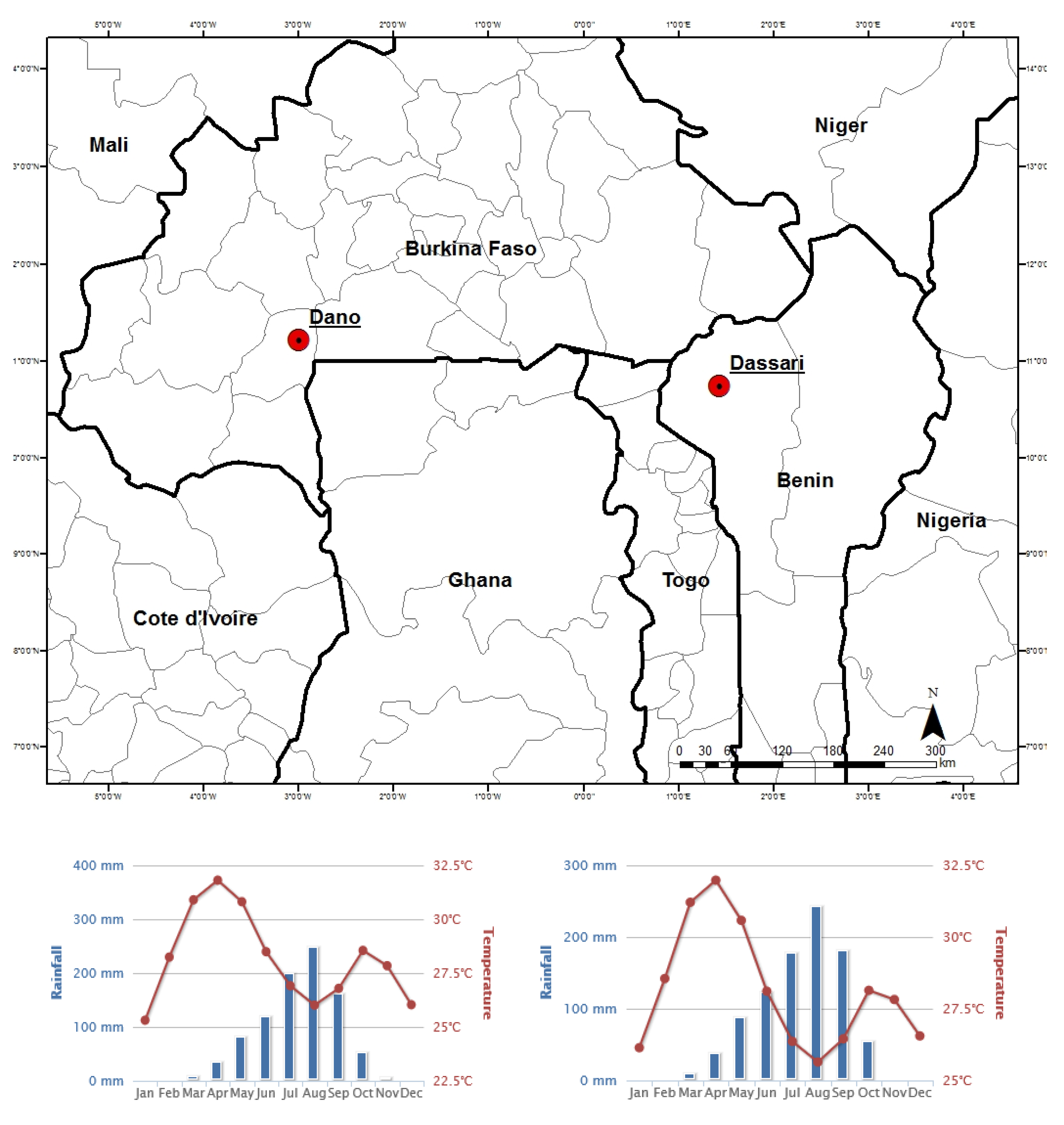

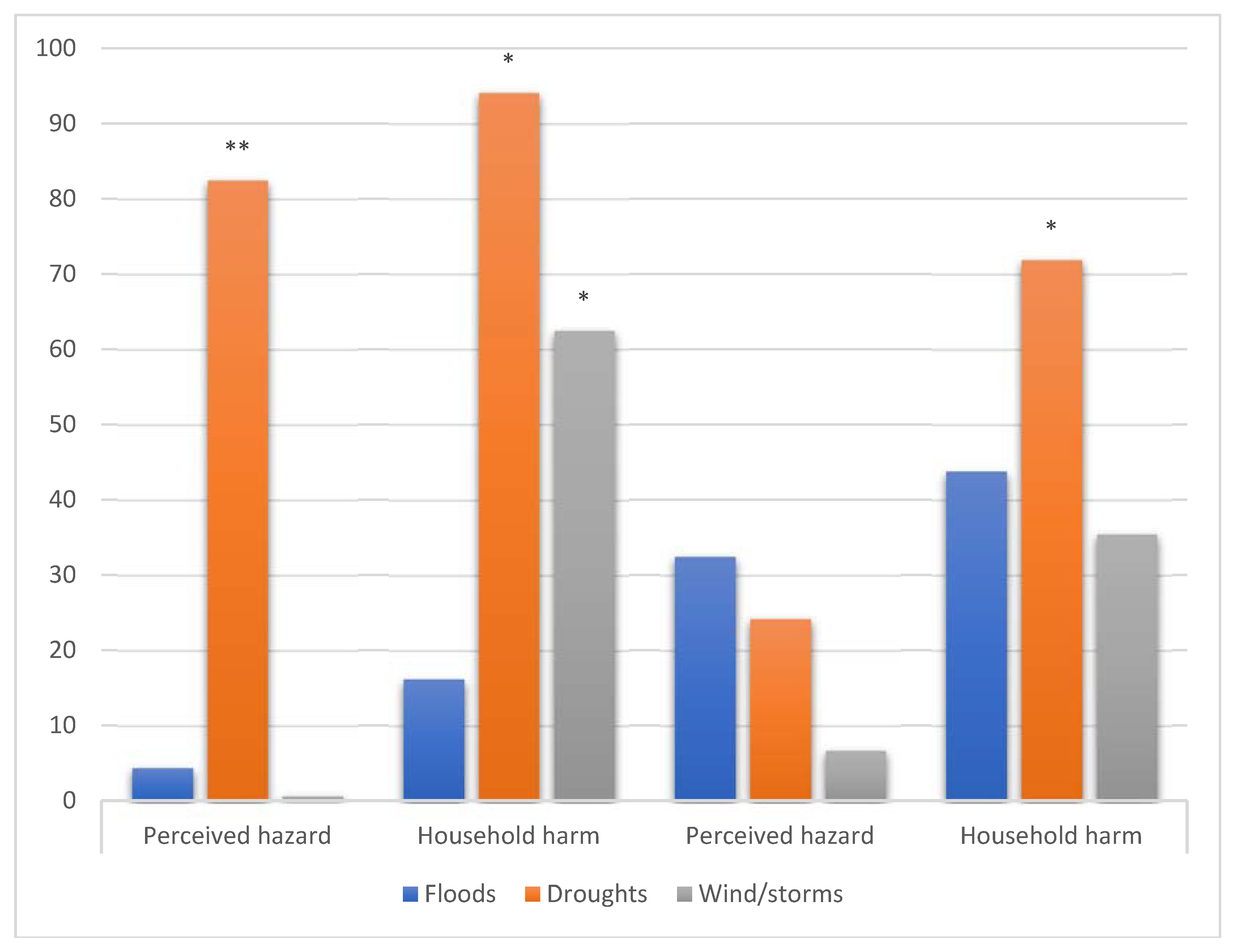

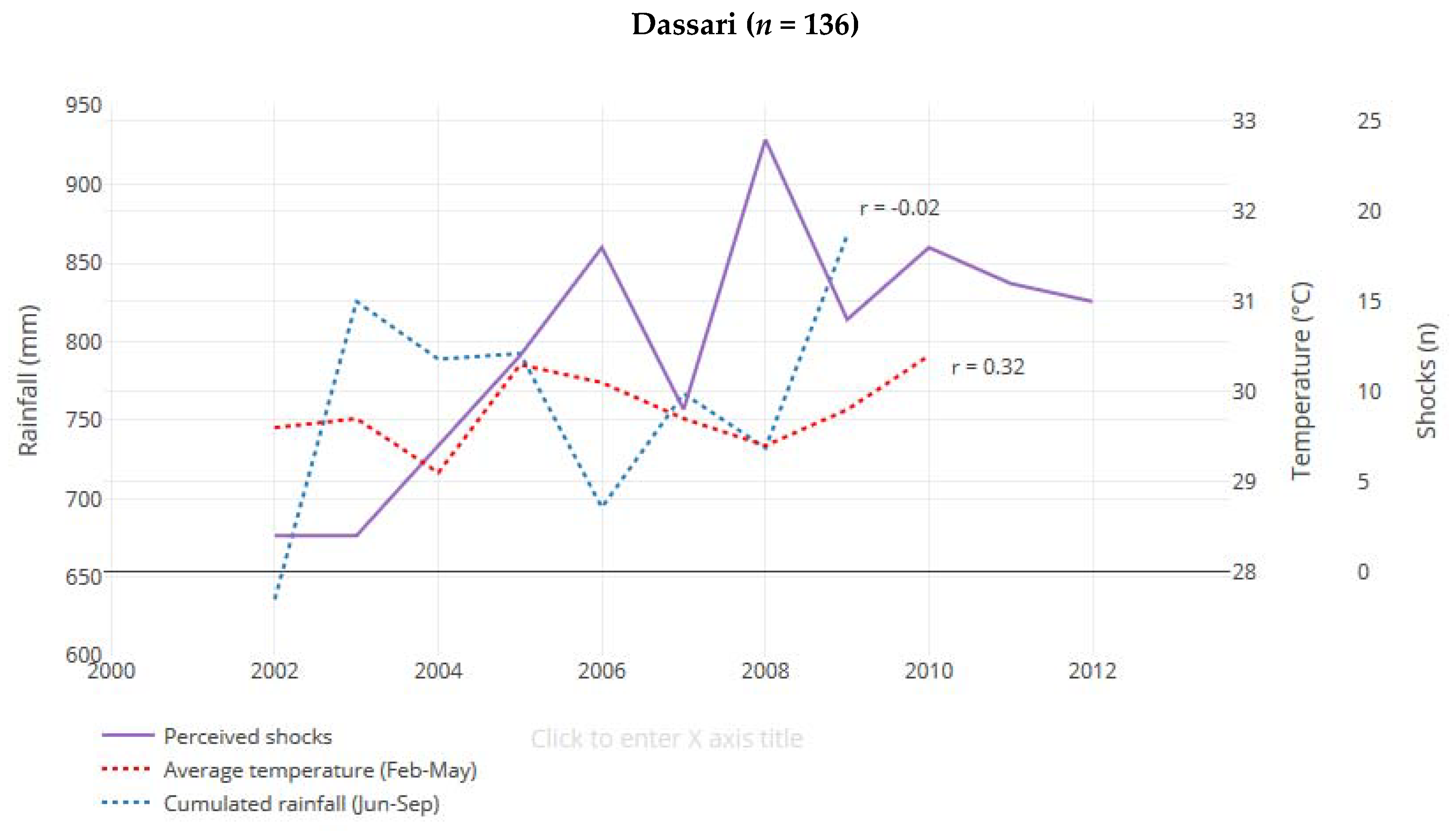
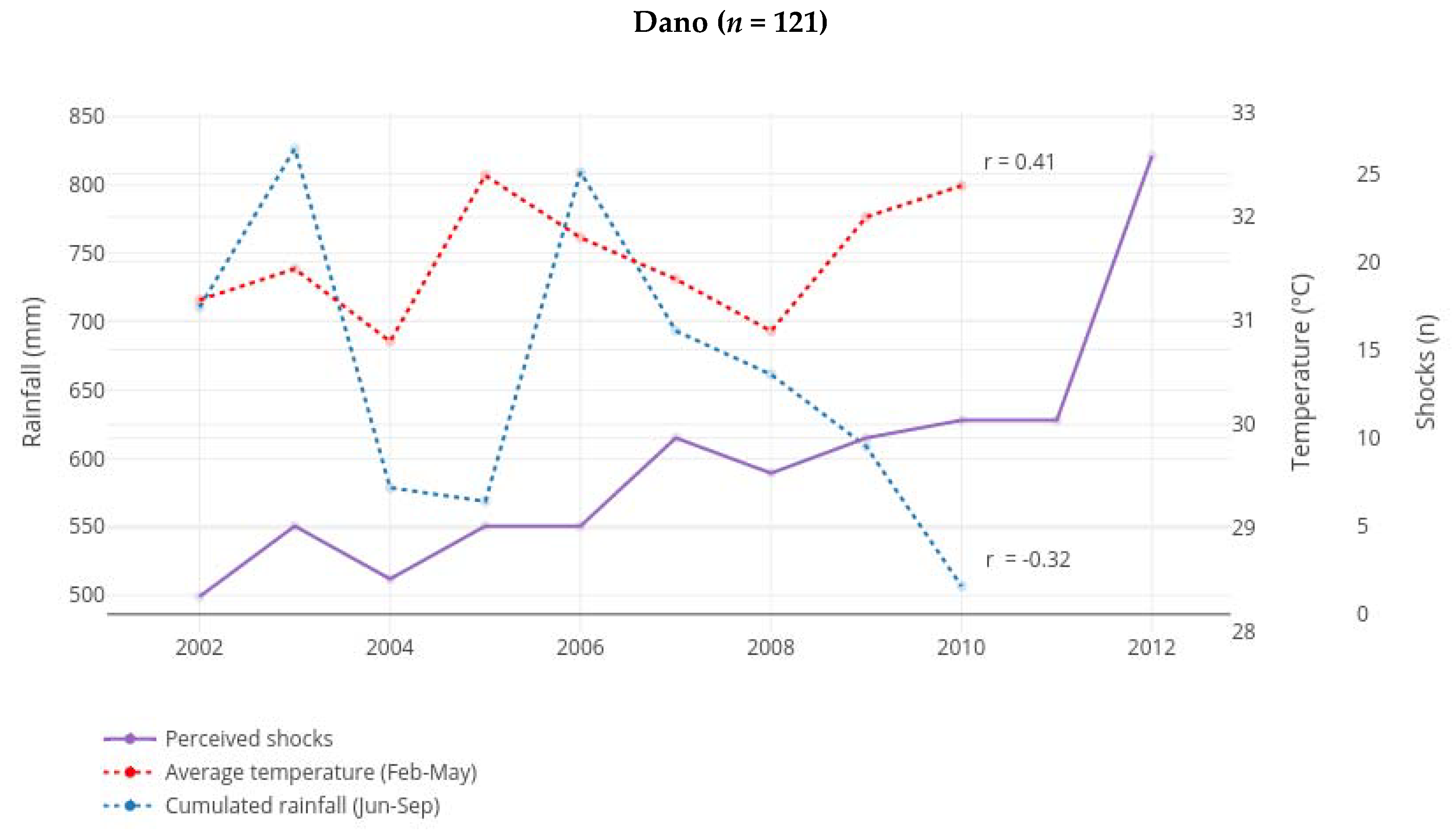
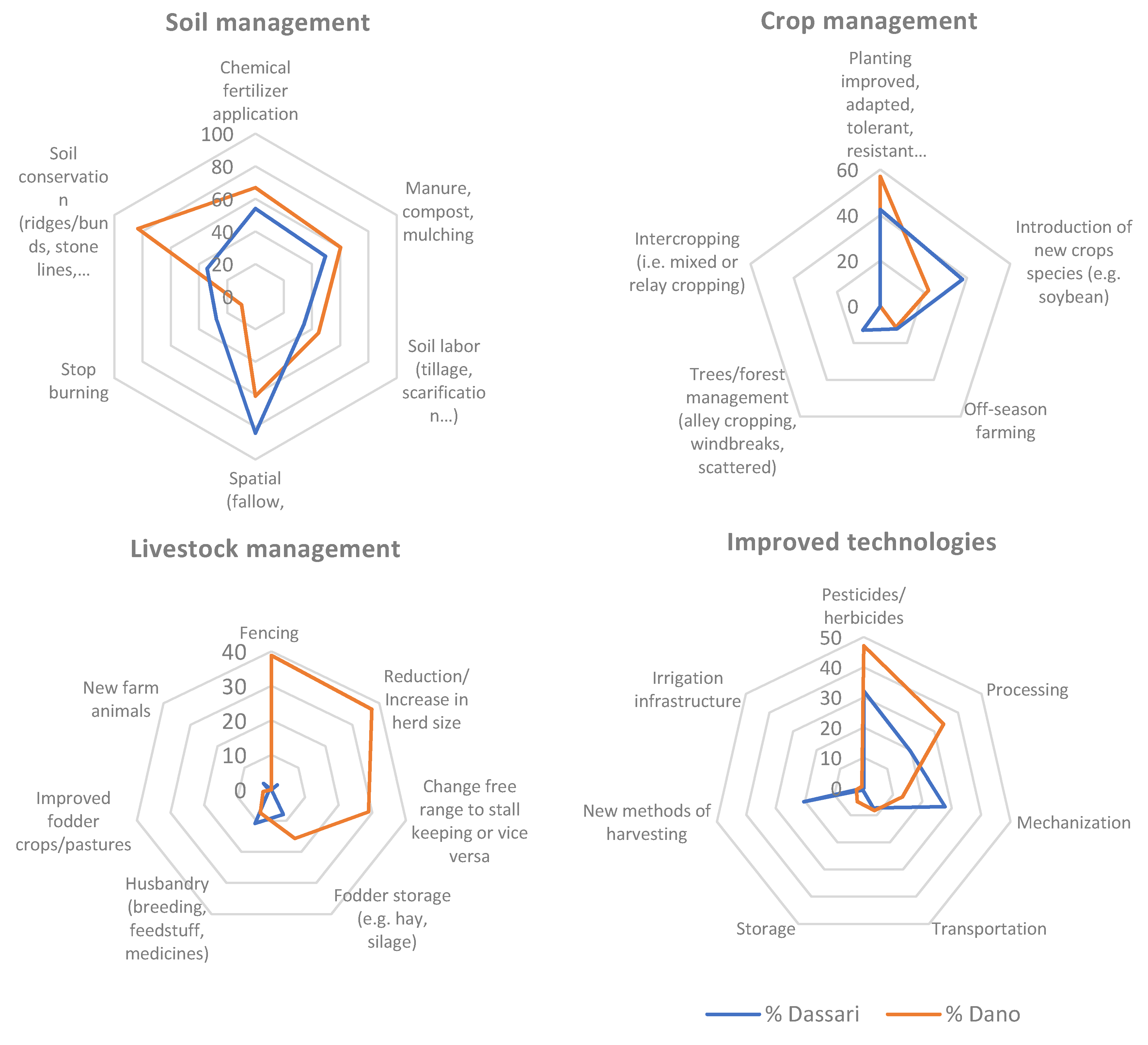
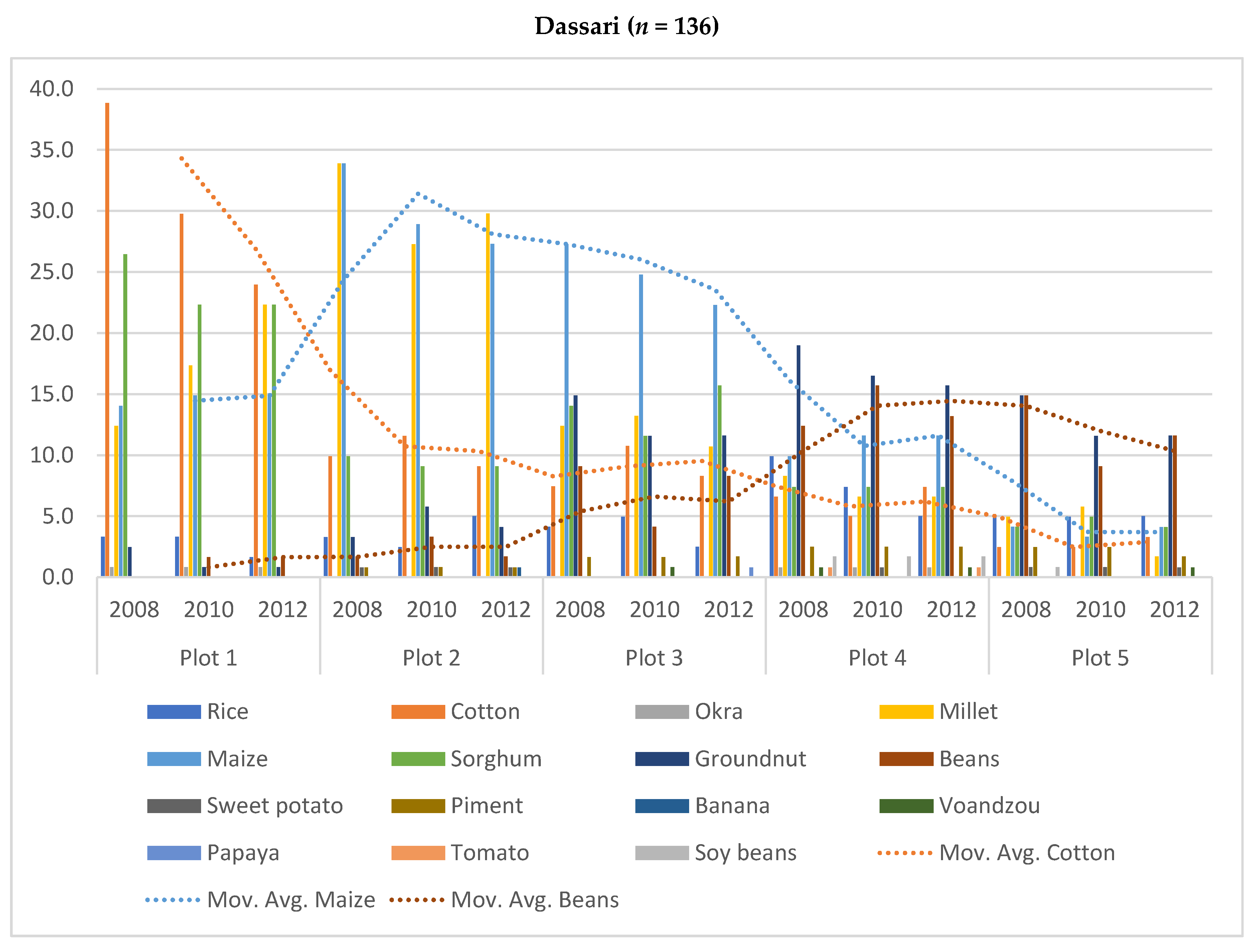
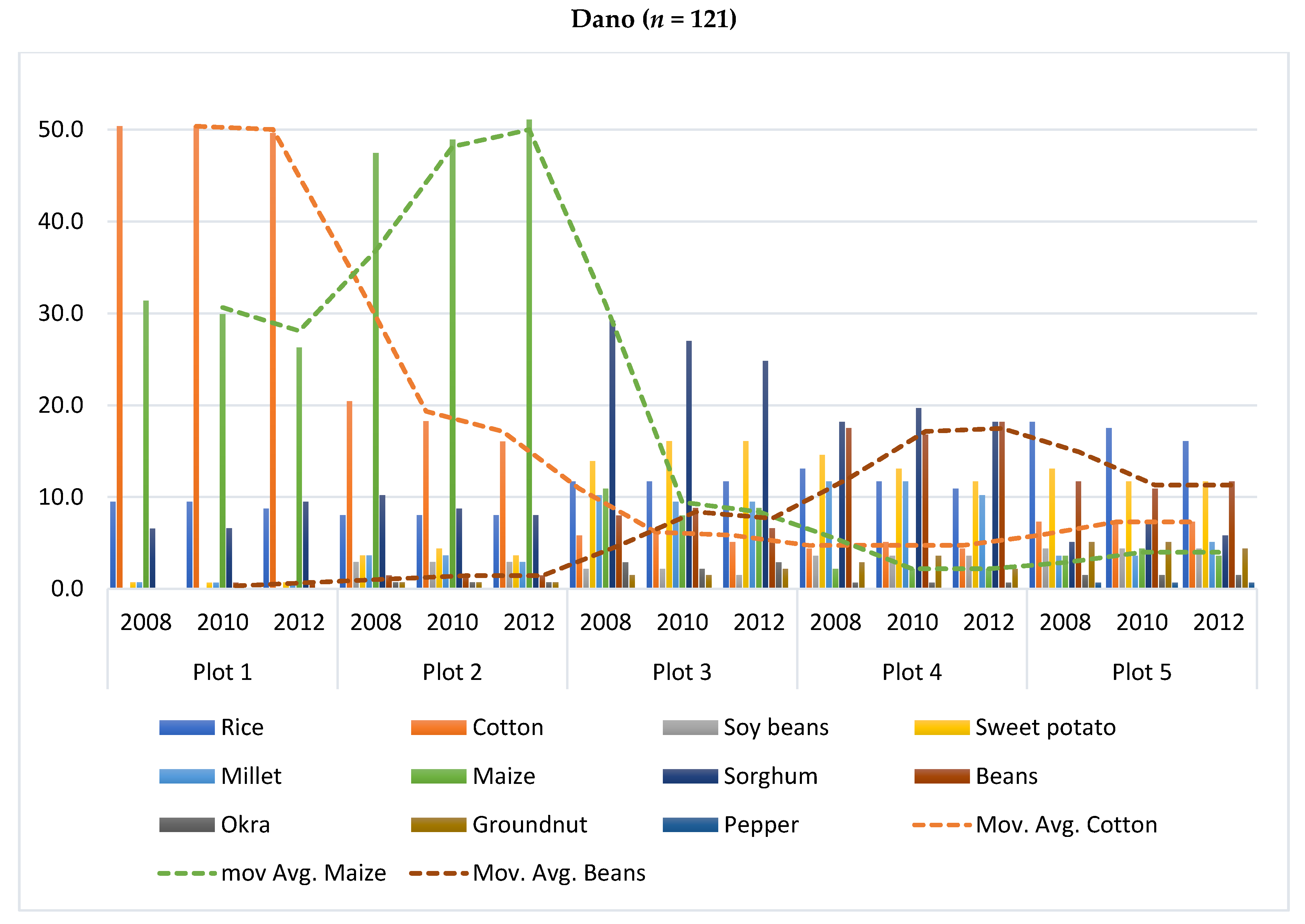
© 2018 by the author. Licensee MDPI, Basel, Switzerland. This article is an open access article distributed under the terms and conditions of the Creative Commons Attribution (CC BY) license (http://creativecommons.org/licenses/by/4.0/).
Share and Cite
Callo-Concha, D. Farmer Perceptions and Climate Change Adaptation in the West Africa Sudan Savannah: Reality Check in Dassari, Benin, and Dano, Burkina Faso. Climate 2018, 6, 44. https://doi.org/10.3390/cli6020044
Callo-Concha D. Farmer Perceptions and Climate Change Adaptation in the West Africa Sudan Savannah: Reality Check in Dassari, Benin, and Dano, Burkina Faso. Climate. 2018; 6(2):44. https://doi.org/10.3390/cli6020044
Chicago/Turabian StyleCallo-Concha, Daniel. 2018. "Farmer Perceptions and Climate Change Adaptation in the West Africa Sudan Savannah: Reality Check in Dassari, Benin, and Dano, Burkina Faso" Climate 6, no. 2: 44. https://doi.org/10.3390/cli6020044




